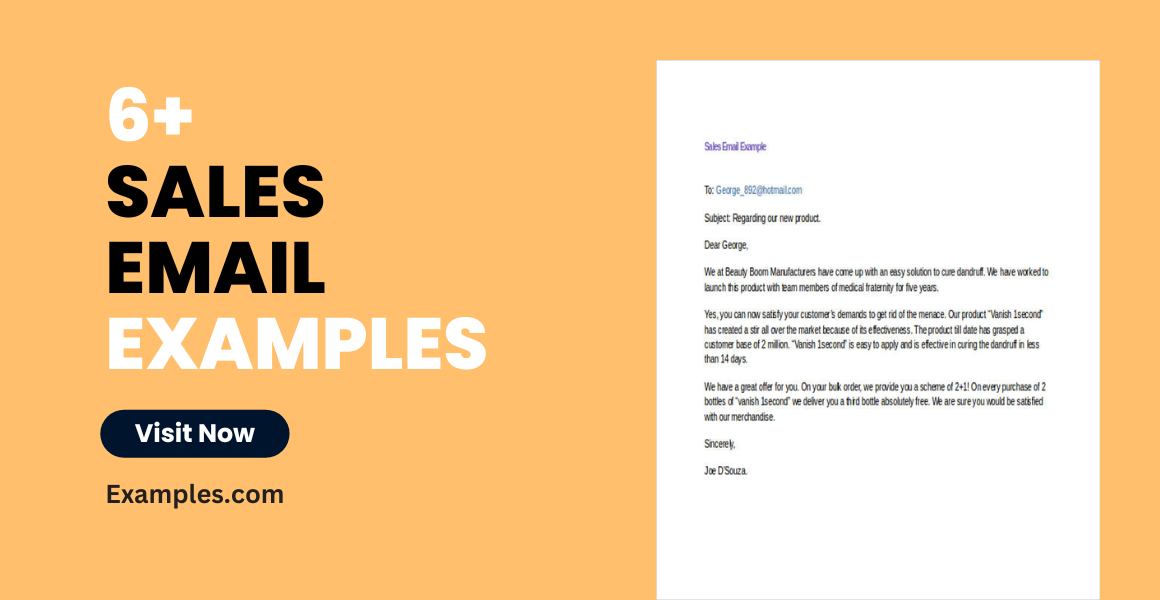6+ Sales Email Examples to Download
The sales email is just like any other formal email. In fact, it does not have that much differences. The only problem is that it is sales email and people would not bother to read it because it talks about sales. Sales email has only around 1 percent response rate. Meaning if you send and email to the 100 potential customers, only one would actually respond to you.
So what is the problem behind all of it? Is it because it is a sales email or because of the content? The answer is the latter. If sales emails do not have many responses it is because of the repetitive content or a boring and plain subject line. Luckily, this article provides you tips in writing a winning professional email.
What is a Sales Email?
A sales email is a type of communication sent to potential or current customers with the intent of promoting a product or service. Its primary purpose is to inform the recipient about the offering and persuade them to make a purchase or take a specific action, such as scheduling a demonstration or signing up for more information. Sales emails are designed to be compelling and persuasive, highlighting the benefits and value of the product or service to the recipient, and often include a call to action to encourage a response.
What is an Examples of a Sales Email?
Here is an Example of a Sales Email:
Examples of a Sales Email
A sales email is a tool used to directly reach out to potential customers, aiming to inform them about a product or service and persuade them to make a purchase or take a specific action. Below is a detailed example of a sales email, highlighting key elements that make it effective.
Subject Line:
“Unlock New Possibilities with Our Cloud Solutions – Special Offer Inside!”
Salutation:
“Hello [Recipient’s Name],”
Introduction:
- Personal Touch: “I hope this message finds you well. I’m reaching out to you specifically because I’ve noticed your company’s impressive growth in the tech industry.”
- Credibility: “As a Sales Manager at CloudTech Solutions, I’ve helped numerous businesses in the tech sector enhance their operational efficiency.”
Body of Email:
- Value Proposition: “Our state-of-the-art cloud solutions are designed to streamline your data management and boost team productivity. With CloudTech, you can expect a 40% increase in data processing speed and a secure, scalable environment for your sensitive information.”
- Social Proof/Testimonials: “Companies like TechInnovate and NextGen have already transformed their workflow with our solutions. TechInnovate’s CTO mentioned, ‘CloudTech’s solution revolutionized our data operations, enhancing both efficiency and security.'”
- Special Offer: “We’re excited to offer you an exclusive 20% discount on your first year with us, available only for companies like yours in the tech sector.”
Call to Action:
- “To see how CloudTech can specifically benefit your business, I’d love to set up a 20-minute call next week. You can also explore our solutions in more detail at [link to website/product page].”
Closing:
- “Thank you for considering CloudTech Solutions for your company’s growth. I’m looking forward to potentially partnering with you to unlock new heights in your business operations.”
Signature:
- “Best regards, [Your Name] Sales Manager at CloudTech Solutions [Contact Information]”
This email starts with a personalized approach, focusing on the recipient’s achievements to build rapport. It then clearly states the value proposition, backed by credible testimonials and a special offer, creating a sense of exclusivity and urgency. The email concludes with a strong call to action, inviting further engagement, and ends on a note of gratitude and professionalism.
How to Write a Sales Email?
Just like any email, such as marketing email and meeting email, the sales emails also contains 5 major components. And this 5 major components should be present in your sales email.
Writing a sales email involves crafting a message that is engaging, informative, and persuasive, without being too aggressive or salesy. Here’s a guideline for creating an effective sales email:
- Subject Line: The subject line should be attention-grabbing and relevant. For example, “Exclusive Offer Just for You – Ends Soon!” or “Solve [a specific problem] with [Your Product/Service].”
- Salutation: Use a personal greeting if you know the recipient’s name. Example: “Dear [Recipient’s Name],”
- Introduction: Start with a brief introduction that establishes who you are and the purpose of your email. Make it relatable and engaging.
- Highlight the Value Proposition: Clearly articulate the benefits of your product or service. Focus on how it can solve the recipient’s specific problem or improve their situation.
- Personalize the Message: Tailor the content to the recipient’s needs, interests, or previous interactions with your company if possible.
- Include Social Proof: Mention customer testimonials, case studies, or success stories to build credibility and trust.
- Call to Action: Encourage the recipient to take the next step, whether it’s scheduling a call, signing up for a demo, or visiting your website. Make it clear and easy to follow.
- Provide Contact Information: Include your contact details for recipients to reach out easily if they have questions or want more information.
- Closing: End with a polite and professional closing, expressing appreciation for their time.
- Signature: Use a professional email signature with your name, position, company, and contact details.
Example Email:
Subject: Improve Your Team’s Productivity with Our Cutting-Edge Project Management Tool
Dear [Recipient’s Name],
I hope this email finds you well. I’m [Your Name], the Account Manager at [Your Company Name]. I noticed that you’re actively looking to enhance your team’s productivity and collaboration.
Our project management tool, [Product Name], has been specifically designed to meet these needs. It offers [briefly describe key features and benefits], helping teams like yours to streamline workflows and collaborate more efficiently.
Clients like [Example Client] have seen remarkable improvements, including a 30% increase in project completion rate. You can read more about their experience here: [link to case study or testimonial].
I would love to show you how [Product Name] can specifically benefit your team. Are you available for a quick 15-minute call next week to discuss this further?
Thank you for considering [Your Company Name]. I look forward to the opportunity to connect with you.
Best regards,
[Your Name]
[Your Position]
[Your Company Name]
[Phone Number]
[Email Address]
6+ Sales Email Examples
Sales Follow-Up Sample
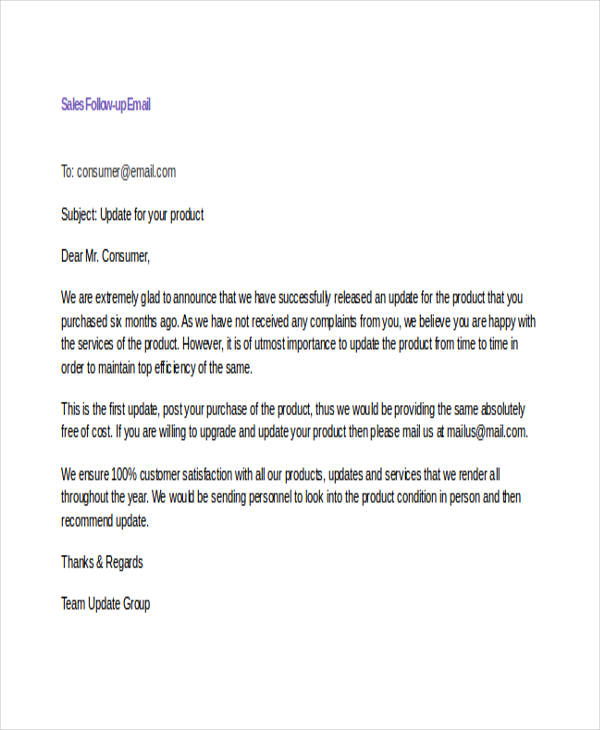
Insurance Sales Email Example
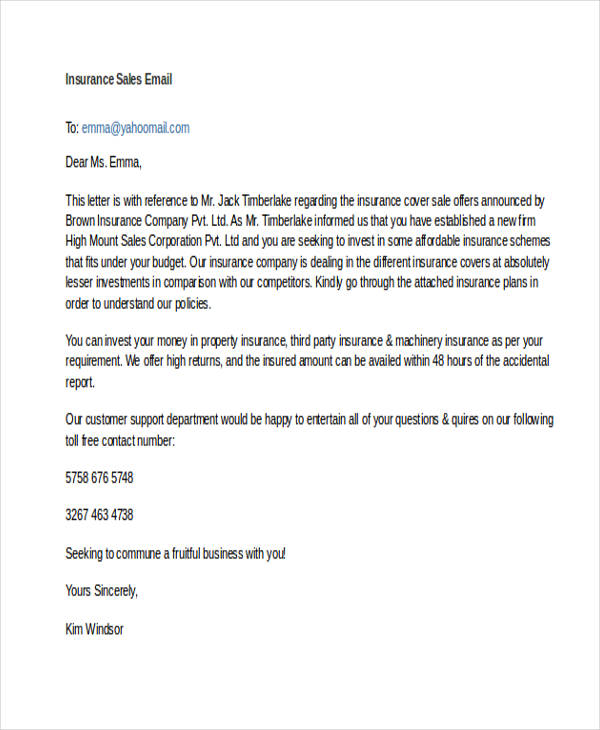
Sales Email Report Sample

How to Write a Professional Email Offering Services?
Writing a professional email offering services requires a clear, concise, and persuasive approach. Here’s a guideline to help you craft an effective email:
Subject Line: Make it attention-grabbing and relevant. For example, “Enhance Your Business Efficiency with Our Customized IT Solutions.”
Salutation: Use a formal greeting. If you know the recipient’s name, use it. Example: “Dear Mr. Smith,”
Introduction: Introduce yourself and your company briefly. Mention how you found their contact information, if applicable.
State the Purpose: Clearly state the reason for your email. Example: “I’m writing to offer our innovative IT solutions designed to streamline business operations.”
Detail Your Services: Briefly describe the services you offer. Highlight key benefits and how they address the recipient’s potential needs or challenges.
Provide Evidence: Include brief case studies, testimonials, or links to your portfolio to showcase your track record and credibility.
Call to Action: Encourage the recipient to take action, such as scheduling a meeting or a call for further discussion.
Contact Information: Include your contact details – phone number, email address, and website.
Closing: Use a professional closing remark like “Sincerely” or “Best Regards,” followed by your name and position.
Example Email:
Subject: Transform Your Digital Presence with Our Expert Web Design Services
Dear Ms. Johnson,
I hope this email finds you well. I’m Jane Doe, the Business Development Manager at WebCreators, a leading web design agency. I came across your company profile in the Local Business Network and noticed that your website could greatly benefit from a redesign to enhance user experience and engagement.
Our team specializes in creating custom, responsive, and user-friendly websites that not only look great but also drive results. We have successfully revamped websites for businesses in your industry, leading to increased traffic, higher engagement, and improved sales.
One of our recent projects involved redesigning the website for XYZ Corp, which resulted in a 40% increase in online traffic and a significant boost in their conversion rate. You can view our work and client testimonials on our website [insert link].
I would love the opportunity to discuss how our services can specifically benefit your business. Are you available for a brief call next week to explore this further? I am happy to work around your schedule.
Thank you for considering our services. I look forward to the possibility of working together to elevate your online presence.
Best Regards,
Jane Doe Business Development Manager WebCreators
Phone: [Phone Number]
Email: [Email Address]
Website: [Website URL]
How to Write Email to Customer for Order?
Writing an email to a customer regarding an order requires a professional and informative tone, ensuring that all necessary details are communicated clearly. Here’s a guideline to help you craft an effective email:
Subject Line: Make it specific and relevant to the order. For example, “Confirmation of Your Order #12345 at [Your Company Name].”
Salutation: Use a formal yet friendly greeting. If you know the customer’s name, use it. Example: “Dear [Customer’s Name],”
Acknowledgment of the Order: Start by acknowledging the receipt of the order and express appreciation.
Order Details: Clearly summarize the order details, including items purchased, quantities, prices, and the total amount.
Payment Information: Confirm the payment status – whether it’s received, being processed, or if further action is needed.
Shipping Details: Provide information on the shipping process, including the estimated delivery date and the shipping method.
Contact Information for Queries: Include contact details for customer service in case the customer has questions or needs assistance.
Closing: End with a friendly closing remark, thanking the customer for their purchase.
Signature: Include a professional email signature with your name, position, and company contact information.
Example Email:
Subject: Your Order #12345 with [Your Company Name] – Confirmation and Next Steps
Dear [Customer’s Name],
Thank you for your recent order with [Your Company Name]. We are delighted to confirm that we have received your order #12345.
Here are the details of your purchase:
- Item 1: [Description], Quantity: [X], Price: $[XX.XX]
- Item 2: [Description], Quantity: [X], Price: $[XX.XX] Total Amount: $[XX.XX]
Your payment has been successfully processed, and your order is now being prepared for shipment. We expect to dispatch your order by [date], and it should reach you by [estimated delivery date]. You can track your order status using this link: [Tracking Link].
If you have any questions or need further assistance, please don’t hesitate to contact our customer service team at [Contact Information].
Thank you for choosing [Your Company Name]. We hope you enjoy your purchase!
Best regards,
[Your Name]
[Your Position]
[Your Company Name]
[Contact Information]
When to Send Sales Emails
The website HubSpot conducted a study on which day and which time of day is ideal for sending sales email. Here’s what they found out.
- Tuesday is the best day of the week to send an email.
- Monday and Wednesday are tied for the second.
- Followed by Thursday and then Friday.
Also, the appropriate time of day is 11 AM EST.
Meeting Email Example
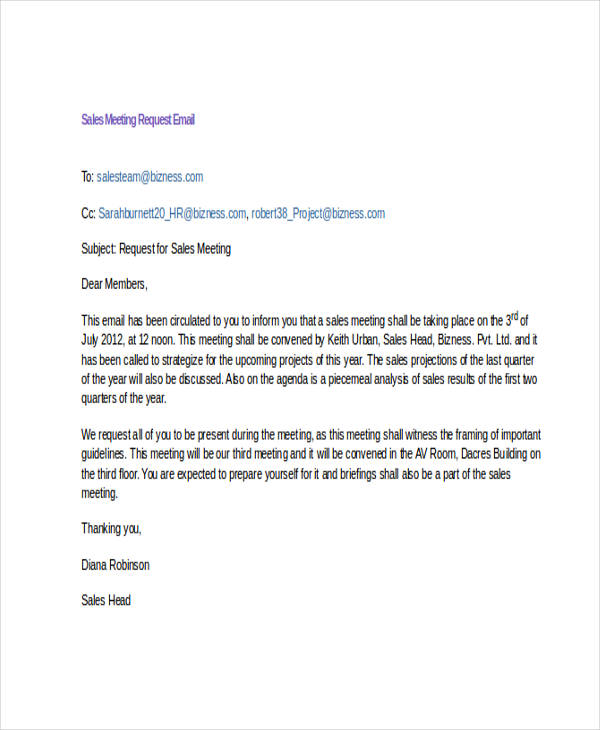
Formal Sending Report Email Sample
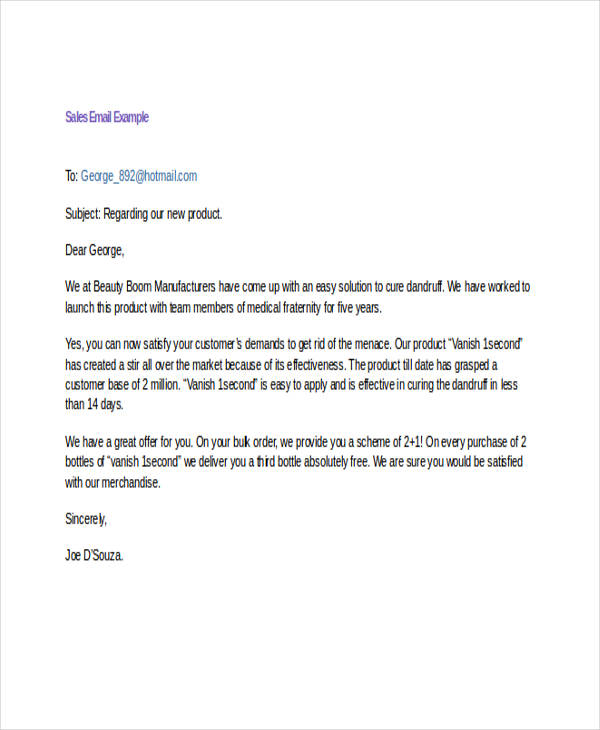
Business Sales Email Example
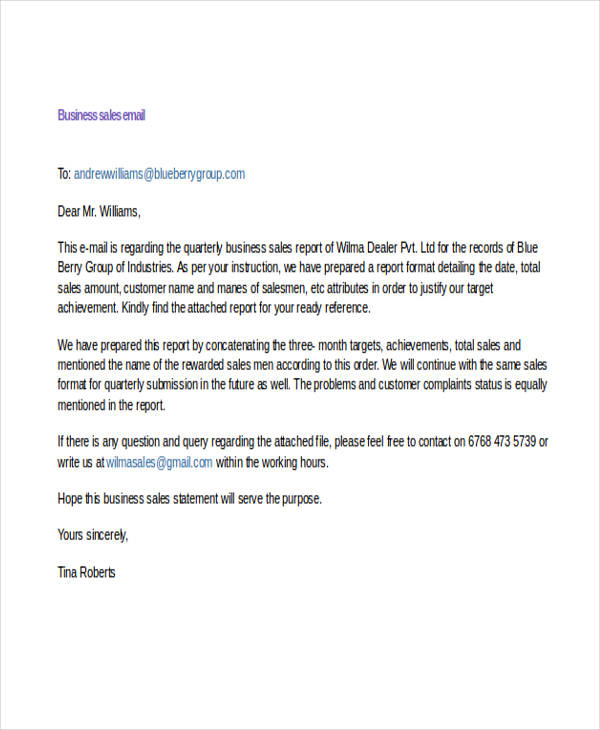
Professional Sales Example
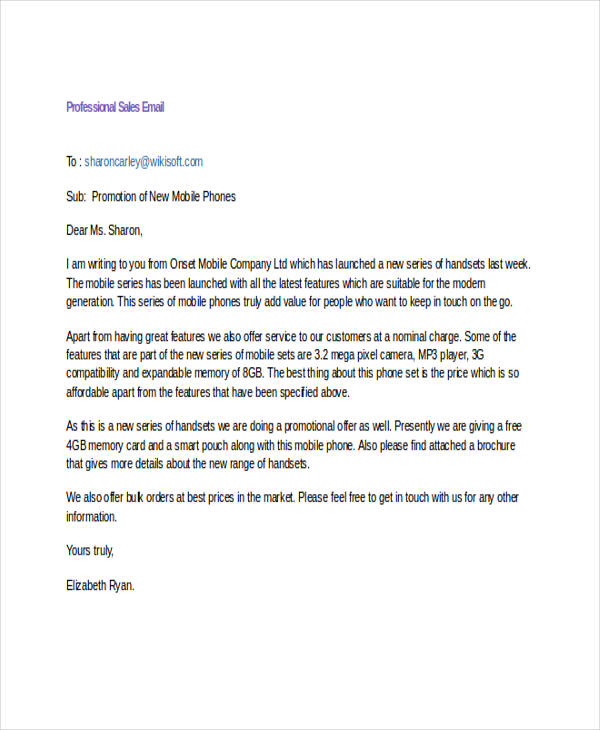
How to Send a Good Sales Email?
Sending a good sales email involves a combination of persuasive writing, personalization, and strategic planning. Here’s how you can create and send an effective sales email:
- Research Your Recipient: Understand your recipient’s business, their role, and potential needs. This knowledge allows you to tailor the email content to their specific context.
- Craft an Engaging Subject Line: Your subject line should be compelling and relevant to the recipient. It’s the first thing they see, so make it count to encourage them to open the email.
- Personalize the Greeting: Use the recipient’s name to make the email feel personal. Avoid generic greetings like “Dear Customer.”
- Write a Compelling Opening Line: Start with a sentence that grabs attention. It could be a relevant question, a surprising fact, or a statement that speaks directly to the recipient’s pain points.
- Clearly State the Value Proposition: Explain how your product or service can benefit the recipient. Be specific about the advantages and how they address the recipient’s needs or challenges.
- Keep It Concise and Focused: Avoid long-winded paragraphs. Keep your email concise, clear, and focused on the recipient’s interests and how you can help.
- Include Social Proof: Add credibility by mentioning other companies you’ve worked with, especially if they are recognizable and relevant to the recipient. Testimonials, case studies, or customer reviews can be persuasive.
- Have a Clear Call to Action (CTA): Be explicit about what you want the recipient to do next – whether it’s scheduling a call, requesting more information, or visiting your website.
- Make it Easy to Contact You: Include your contact information, such as your phone number and email address, to make it easy for the recipient to reach out.
- Proofread and Test Your Email: Check for typos, grammatical errors, and ensure all links work. These details impact the professionalism of your email.
- Follow Up Strategically: If you don’t receive a response, send a follow-up email in a few days to a week. Be persistent but not pushy.
- Use a Professional Email Signature: End with a professional signature that includes your full name, position, company name, and contact details.
Tips on Writing an Effective Sales Email
It very unlikely for people to open an email if the subject line or the first statement they see would not catch their attention. Chances are, it will just be deleted. So, to help you in writing a sales email that people would actually open and respond to, here are the few tips that might just do the trick.
- Create a catchy, interesting, and simple subject line. No doubt that the subject line of your email is the first thing that the recipient would see before clicking and opening your email message. From there, create a compelling subject line that will make the recipient interested by just reading on the subject line.
- Make it short, sweet, and simple. The body of your email thank you should be short enough that it states all the information you want to provide. That way, it will not take a long time in reading it.
- Omit jargon, complex language, and terminologies that only you can understand. This is very important because the person whom you are sending to may not what you are talking about.
- Rewrite it. The key to an effective sales email is by rewriting it. It will eliminate unnecessary information and promote brevity.
FAQs:
How to Write an Effective Sales Email?
Write an effective sales email by personalizing the content, clearly stating the value proposition, keeping it concise, and including a compelling call to action.
What Makes a Sales Email Successful?
A successful sales email resonates with the recipient’s needs, clearly communicates benefits, is personalized, and contains a clear and persuasive call to action.
How Often Should You Send Sales Emails?
Frequency of sales emails should balance persistence with respect for the recipient’s inbox; typically, once a week follow-up is considered reasonable.
What Should be Included in a Sales Email?
A sales email should include a personalized greeting, a clear value proposition, brief and relevant content, social proof, and a strong call to action.
How Long Should a Sales Email Be?
A sales email should be brief and to the point, ideally under 200 words, to maintain the recipient’s interest and convey the message effectively.
Can Sales Emails be Automated?
Sales emails can be automated, especially for follow-ups or part of a larger marketing campaign, but should still be personalized and targeted.
How to Personalize Sales Emails?
Personalize sales emails by using the recipient’s name, referencing specific needs or interests, and tailoring the message to their particular situation or industry.
What is the Best Time to Send Sales Emails?
The best time to send sales emails varies, but generally, mid-week mornings are effective, as emails are more likely to be read during this time.
How to Measure the Success of Sales Emails?
Measure the success of sales emails by tracking metrics such as open rates, click-through rates, response rates, and conversion rates.


